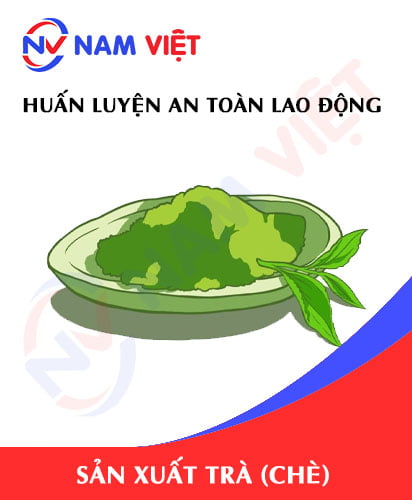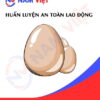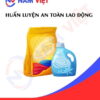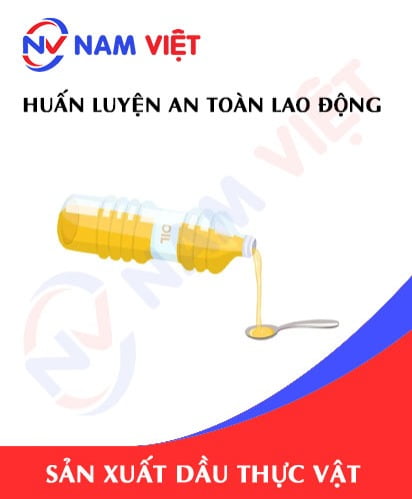Occupational Safety Training for Tea Manufacturing
99,000 ₫
Note: The above price is calculated for one person, the price may fluctuate depending on the number of trainees participating in the course and the market movement. For more accurate price support, please refer to the price list or contact our consulting staff directly.
Occupational safety is an important issue in tea manufacturing factories and needs to be addressed promptly to ensure the health and safety of workers and to enhance the reputation of businesses. The Occupational Safety Training course is one of the effective solutions to raise awareness of how to prevent occupational accidents for workers in tea manufacturing.
Table of Contents
Toggle1. Overview of Tea
a. What is Tea?
- Tea is a type of beverage made from the leaves, branches, and buds of the tea plant (Camellia sinensis). Tea is considered one of the most popular drinks in the world and has many different types with various flavors, colors, and freshness levels. Tea can be manufactured from different kinds of tea leaves such as black tea, green tea, oolong tea, white tea, and pink tea. These teas are manufactured in many countries worldwide, but Asian countries such as China, India, Japan, and Vietnam are famous for tea manufacturing.
- Vietnam is one of the largest tea manufacturing countries in the world, ranking 6th in global tea production. The country has natural conditions and a suitable climate for growing tea plants, especially in the highland regions of the Central Highlands and Tay Nguyen.
- Popular teas manufactured in Vietnam include green tea, black tea, and Oolong tea. Green tea and black tea are manufactured in major tea-growing areas such as Son La, Phu Tho, Yen Bai, Lam Dong, and Dak Lak. Oolong tea is often manufactured in the Northwestern region of Vietnam.

b. Types of Tea Manufacturing Machinery
The types of machinery and equipment used in tea processing include:
- Tea leaf plucking machine: Used to pluck tea leaves from the tea plant, ensuring proper quality and fineness.
- Tea drying machine: Used to dry tea leaves, remove moisture, and create the distinctive flavor of each type of tea.
- Tea grinding machine: Used to grind dried tea leaves into tea powder.
- Tea mixing machine: Used to mix tea powder with flavorings to create a special type of tea.
- Tea packaging machine: Used to pack tea into tea bags, boxes, or large packages for convenient storage and use.
- Tea pressing machine: Used to press tea into tea cakes or tea tablets.
In addition, there are other auxiliary devices such as mixing tanks, fermentation tea processing machines, tea seed separating machines, manual tea pressing machines, and semi-automatic tea pressing machines.

c. Typical Tea Manufacturing Enterprises in Vietnam
Vietnam is one of the largest tea manufacturing countries in the world and has many typical tea manufacturing enterprises. Below are some famous tea manufacturing enterprises in Vietnam:
- Tra Viet: A well-known tea brand in Vietnam, manufacturing and distributing specialty tea products.
- Lam Dong Joint Stock Company Tea: Manufactures tea in Lam Dong province with many specialty teas such as black tea, green tea, Oolong tea, and fresh tea.
- Thai Nguyen Tea: One of the most famous tea brands in Vietnam with products including black tea, green tea, and flavored tea.
- Shan Tuyet Tea: Manufactured in the high mountainous region of Sapa, Lao Cai, mainly producing green tea and black tea.
- Ha Giang Golden Tea: Manufactured in Ha Giang, mainly producing green tea, black tea, and fresh tea.
- Son La Tea: Manufactured in Son La, mainly producing fresh tea, green tea, and black tea.
- Phuoc Loc Tho Tea: A specialty tea manufacturing enterprise in Da Lat, Lam Dong.
d. Specific Jobs in Tea Manufacturing Factories
Group 1
- General director, deputy general director, and department heads in tea manufacturing factories.
Group 2
- Safety officers: managing safety in the factory, designing safety procedures, supervising, and urging employees to comply with safe working procedures.
Group 3
- Tea harvesting: Harvesting fresh and high-quality tea leaves for processing.
- Preliminary processing: Removing young leaves, cleaning, and eliminating fragrances of young leaves to create the tea’s flavor and aroma.
- Tea flavoring: Putting tea into filter bags and steeping in hot water to create flavor and beautiful color.
- Tea drying: To ensure long-term preservation, tea must be dried using dryers or manually to remove moisture.
- Tea sieving: Separating dry tea leaves from particles by sieving, ensuring the quality and purity of tea.
Group 4
- Office work, service, sales, marketing.
- Production management, quality management, human resources management, material management, financial and accounting management.
- Research and development of new products, packaging design.

2. Overview of Occupational Safety Training for Tea Manufacturing
In this article, we focus on issues related to group 3, because group 3 is the group directly involved in the manufacturing process and is exposed to the highest occupational safety risks. Refer to other groups here
a. What is Group 3 Occupational Safety Training?
- Occupational safety training group 3 consists of lessons that provide awareness on how to prevent occupational accidents for workers.
- The occupational safety training course helps workers recognize and avoid hazards, reducing the risk of occupational accidents during work.
REGISTER FOR OCCUPATIONAL SAFETY TRAINING SERVICE
b. Training Duration
Initial safety training duration
- Total training duration is at least 24 hours, including test time.
- 8 hours of theoretical learning about the system of occupational safety and health policies and laws
- 8 hours of theoretical learning about basic occupational safety and health knowledge
- 4 hours of theoretical learning about specialized training content
- 2 hours of practical training on specialized training content
- 2 hours of theoretical test at the end of the training course
The safety training center will allocate time into multiple sessions depending on the scheduling for employees. Normally, there will be 6 sessions over 3 days, provided the manufacturing enterprise arranges continuous study time.
Periodic safety training duration
- Before the occupational safety card expires, workers who want to renew must undergo periodic occupational safety training, with training duration of at least 50% of the initial safety training duration.
Explanation: the total duration of periodic occupational safety training is at least 12 hours, including test time. After completing the periodic training and passing the test, the worker will be reissued or have their occupational safety card extended.
c. Training Content
| No. | TRAINING CONTENT | TRAINING DURATION (HOURS) | |||
| Total | Including | ||||
| Theory | Practice | Test | |||
| I | System of occupational safety and health policies and laws | 8 | 8 | 0 | 0 |
| 1 | Overview of the system of legal documents on occupational safety and health. | 6 | 6 | ||
| 2 | System of occupational safety and health standards and technical regulations. | 1 | 1 | ||
| 3 | Specific regulations of state management agencies on occupational safety and health when constructing new, expanding, or renovating facilities for manufacturing, using, storing, preserving, and testing machines, equipment, materials, and substances requiring strict occupational safety and health standards. | 1 | 1 | ||
| II | Basic knowledge of occupational safety and health | 8 | 8 | 0 | 0 |
| 1 | Basic knowledge about hazardous and harmful factors in the workplace. | 4 | 4 | ||
| 2 | Methods of improving working conditions. | 1 | 1 | ||
| 3 | Safety culture in manufacturing and business. | 1 | 1 | ||
| 4 | Rights and obligations of employers and employees; policies and regimes on occupational safety and health for employees; functions and tasks of the occupational safety and health network. | 1 | 1 | ||
| 5 | Occupational safety and health regulations, signs, instructions, and use of safety equipment, personal protective equipment; professional skills in first aid for occupational accidents, prevention of occupational diseases. | 1 | 1 | ||
| III | Specialized training content | 6 | 4 | 2 | 0 |
| General knowledge about machines, equipment, substances generating hazardous and harmful factors; analysis, assessment, and risk management in occupational safety and health; safe working procedures with machines, equipment, and substances requiring strict occupational safety and health standards. | 6 | 4 | 2 | ||
| IV | Final test on occupational safety training content | 2 | 2 | 0 | 0 |
| Total | 24 | 22 | 2 | ||
See more training content of 6 groups
d. Occupational Safety Card
After completing occupational safety training and passing the test, the worker will be granted an occupational safety card (commonly known as a group 3 occupational safety certificate).
The group 3 safety card will clearly state information such as full name, date of birth, job, and specific working environment. It also includes training duration, red stamp, and signature confirming completion of the training.
According to the regulations on issuing safety cards specified in Clause 2 of Article 24 of Decree 44/2016/ND-CP, there are two cases:
- If the employer and employee have a labor contract, the employer must stamp and sign the safety card for Group 3 employees after they complete training from an occupational safety training unit and pass the test.
- If the worker is freelance or seasonal without a labor contract, the training unit must stamp and sign the safety card after the worker completes training and passes the test.

3. Identifying hazards affecting workers in tea manufacturing
Hazards affecting workers in tea manufacturing include:
- During tea manufacturing, machinery can generate thermal effects, electrical short circuits, high pressure, and flammable liquids. Therefore, it is necessary to ensure safety in the use of power sources and lighting, and to keep the workspace clean and ventilated to minimize the risk of fire and explosion.
- Workers directly exposed to tea must maintain personal hygiene and wash hands before performing tasks related to tea. Personal protective equipment such as masks, gloves, aprons, and safety shoes must be used to minimize the risk of infection or poisoning.
- Tea manufacturing machinery can cause accidents such as collisions, falling objects, cuts, crushing, entrapment, or being pierced by machine parts. Therefore, it is necessary to fully implement occupational safety measures such as using protective equipment, avoiding wearing jewelry while working, and preventing unskilled individuals from operating machines.
- During the manufacturing process, dust and chemicals may be released from machines or raw tea materials. Tea production workers must be provided with protective equipment to minimize exposure to dust and hazardous chemicals, as well as trained to handle chemicals safely and properly.
- If electrical equipment in the factory is not regularly maintained, insufficiently insulated, or not waterproof, it may pose an electrocution hazard to workers during manufacturing.
4. Common types of occupational accidents in tea manufacturing
Common types of occupational accidents that may occur during tea manufacturing include:
- Chemical poisoning: Chemicals used for pest control or tea preservation can cause poisoning if not used properly.
- Physical injuries: Due to the movement and handling of heavy loads, workers may suffer injuries from collisions or accidents if protective equipment is not properly used.
- Electrocution: Electrical machines and devices can endanger untrained workers or those not using proper protective equipment.
- Fire and explosion: The use of flammable substances or fuels for equipment operation exposes tea workers to fire and explosion risks.
- Unsafe working conditions: Working in environments with high humidity, insufficient lighting, or poor ventilation may also pose health risks to employees.
5. Safety measures in tea manufacturing
Ensuring worker safety during tea manufacturing is essential to prevent occupational accidents and protect employee health. Below are some safety measures to be implemented in tea production:
- Ensure food safety and hygiene: Tea is a consumable product, therefore processes related to tea processing must comply with food safety regulations. Employees must be trained to follow hygiene practices, including washing hands before work, using personal protective equipment, and keeping equipment and the workplace clean.
- Use personal protective equipment: The use of personal protective equipment such as helmets, masks, gloves, and safety glasses helps reduce risks of injury and allergic reactions caused by exposure to chemicals during production.
- Proper use of machinery: Workers must be trained to properly use machinery and necessary tools, ensuring safety for themselves and others.
- Ensure safety in transportation: Tea transportation must also be safe to prevent product damage and accidents during transit.
- Implement risk management: Tea factories must have risk management plans and response measures in case of accidents or incidents.
- Provide occupational safety training: Workers must be trained in occupational safety measures and made aware of risks associated with tea production.
- Conduct regular occupational environment monitoring in factories and enterprises, collecting and analyzing harmful factors for workers, thereby reducing risks to prevent occupational diseases.

6. Benefits of occupational safety training in tea manufacturing
An Toan Nam Viet provides enterprises with significant benefits after completing occupational safety training courses in accordance with Decree 44/2016/ND-CP on occupational safety and hygiene. These benefits include:
- Workers can identify potential occupational accident risks and adopt preventive measures to avoid accidents.
- Enterprises can establish risk prevention measures in production, operation, and maintenance processes.
- Minimize costs incurred due to occupational safety incidents.
- Uninterrupted production increases labor productivity and product quality.
- Compliance with occupational safety laws, avoiding legal risks.
- Enhance credibility and professionalism, thereby elevating the enterprise’s brand.
Nam Viet’s training courses are solutions to prevent external risk factors from harming workers, helping them avoid dangers that may lead to injuries or fatalities.
REGISTER FOR OCCUPATIONAL SAFETY TRAINING SERVICES
7. Customer feedback after completing occupational safety training in tea manufacturing
An Toan Nam Viet has years of experience accompanying many enterprises across Vietnam in general and particularly in southern provinces. This responsibility is extremely valuable to Nam Viet, which is why our Occupational Safety Training work is increasingly emphasized and professionalized. The motivation for Nam Viet’s growth comes from both positive feedback and constructive comments from businesses. Below are testimonials from partners we have served.
Bac Nam E&C Construction Investment Joint Stock Company
“This was the first time I used the service at An Toan Nam Viet and I was very impressed by the 24/7 enthusiastic support from the consulting team. Class organization was fast and convenient for our company, thank you very much for Nam Viet’s service!”
Hoa Dat Construction and Trading Joint Stock Company
“Nam Viet’s service has greatly assisted us in simplifying occupational safety and completing safety documentation for our work processes. The consulting team was enthusiastic and timely in addressing our inquiries. Five stars for Nam Viet.”
See more customer interviews after using services of An Toan Nam Viet
8. Occupational safety training capacity of An Toan Nam Viet
An Toan Nam Viet is a reputable and high-quality occupational safety training center in Vietnam. Safety training sessions are held continuously at production workshops, factories, and construction sites across the country (63 provinces and cities in Vietnam).
REGISTER FOR OCCUPATIONAL SAFETY TRAINING SERVICES
Occupational safety training license
- An Toan Nam Viet has been inspected and certified by the Occupational Safety Department of the Ministry of Labor, Invalids and Social Affairs, granting certification of eligibility for occupational safety and hygiene training activities. This further strengthens our capacity in occupational safety training.

Training materials and lectures
- Before occupational safety training materials are included in safety training courses, they are reviewed and verified to ensure accuracy and effectiveness when applied.
- The teaching methods of instructors are standardized according to An Toan Nam Viet training standards, developed by occupational safety experts to maximize knowledge absorption for learners.
Facilities
- Controlling classroom environmental factors enhances teaching efficiency and knowledge absorption.
- Our training facilities always meet standards for space, lighting, and equipment for safety training courses.
9. Nationwide reputable occupational safety training center
At An Toan Nam Viet, we always place professional commitment to occupational safety training as our top priority. For us, imparting knowledge of self-protection to workers so that they are equipped with safety awareness in their livelihood journey contributes to building the nation.
To ensure effective training, we meticulously prepare even the smallest details, from teaching tools, equipment, and curricula to sound and lighting systems.
Our occupational safety trainers are experienced experts, with research on hazard identification across industries and ways to prevent them.
Their lectures are drawn from practical experience and conveyed in a lively, easy-to-understand manner for workers. This helps workers feel comfortable during learning and absorb knowledge effectively. Training content always adheres to Decree 44/2016/ND-CP.
As a result, workers acquire multiple preventive measures against hazards and know how to apply them appropriately in real work.
Our safety training center is proud to provide professional and reputable occupational safety training services with the following advantages:
- Competitive training costs while ensuring quality training.
- Flexible training schedules aligned with company production.
- Quick certification procedures in compliance with the law.
- Instructors with many years of industry experience.
- Controlled classroom factors that enhance teaching efficiency and learner knowledge absorption.
- Lectures tailored to occupational safety practices at enterprises.
- An Toan Nam Viet works with dedication and professionalism to provide customers with accurate and prompt support.

10. Additional reference materials for occupational safety training in tea manufacturing
- Occupational safety materials for tea manufacturing
- Occupational safety training material set
- Occupational safety training test set
- Occupational safety multiple-choice test in tea manufacturing
- Training slides on occupational safety in tea manufacturing
1 review for Occupational Safety Training for Tea Manufacturing
No comments yet















namchinh.haiphong341
Dịch vụ huấn luyện an toàn lao động rất tốt nhé, giảng viên dạy rất sinh động dễ hiểu!